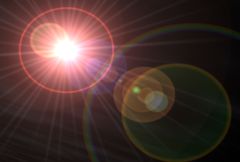S_LensFlareAutoTrack
Renders a lens flare image over the background clip, aligning various flare elements between the hotspot and pivot locations. In this AutoTrack version of LensFlare, the hotspot is automatically positioned on the brightest area of the background clip. If there are multiple areas with the same maximum brightness, their locations are averaged. Increasing Blur For Auto will cause the input to be smoothed before the brightest location is found and can help remove the effect of secondary bright spots.In the Sapphire Lighting effects submenu.
Inputs:
-
Background: The current layer. The clip to apply the lens flare over.
- Track: Defaults to None. The lensflare hotspot is positioned on the brightest part of this image. If this input is not selected, the Background input (current layer) is also used for the tracking.

|